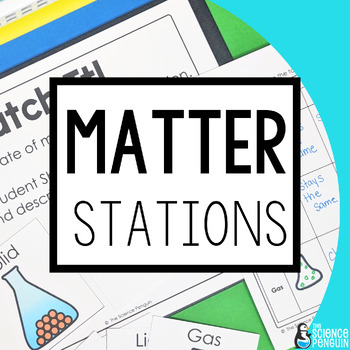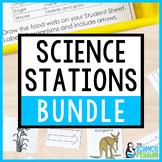Physical Properties of Matter Stations | Reading Passage, Sort, Worksheets
- PDF
What educators are saying
Also included in
- The Science Stations Units Bundle includes 13 physical, earth, and life science sets for a total of 117 stations. The topics are: ecosystems, natural resources, erosion, adaptations, space, properties of matter, changes to matter, mixtures, energy, weather and water cycle, force, Earth's spheres, anPrice $49.95Original Price $78.00Save $28.05
- This bundle includes labs, stations, slides and notes, a flipbook, task cards, a sort, digital activities, and vocabulary review activities for properties of matter including relative density, mass, volume, conductivity, magnetism, and solubility.I created this particular bundle of 13 resources forPrice $29.95Original Price $41.00Save $11.05
Description
Properties of Matter Science Stations includes 9 station activities that focus on identifying physical properties of matter like relative density, solubility, mass, physical state, magnetism, and conductivity.
Includes guided student sheets, an answer key, quicker prep, and improved activities for your class!
9 Stations
Read It: Read about seven physical properties of matter. Answer questions.
Create It: Test the magnetism of 6 objects and create a table with the results.
Watch It: Watch two videos and answer questions.
Match It: Match the physical state to its description and complete a table.
Analyze It: Interpret a table that includes the physical properties of mystery substances.
Draw It: Draw a picture for each term – magnetism, solubility, conductor, and insulator.
Explore It: Students conduct tests to identify what a mystery substance is (baking soda). They identify color, texture, solubility, and reaction with vinegar.
Explain It: Explore the relative density of 6 objects.
Sort It: Sort physical properties of an iron nail and a sugar cube.
________________________________________________
Teachers Love It!
⭐️⭐️⭐️⭐️⭐️ This is such a fantastic resource! Students were engaged and actively learning. Bonus- very little prep on my part! This will be my go-to resource in the future. We are now prepping for state testing and I am using the materials again for review! LOVE the updates. Thank you!!!! -Leslie S.
⭐️⭐️⭐️⭐️⭐️ These activities are great! They challenge the students, but they are not complicated. The students could read the directions and work on their own with little instruction from me. This allowed me to walk around to all groups and listen in to their learning. -Christy B.
⭐️⭐️⭐️⭐️⭐️ I am so glad I bought this as a hands-on add-on for the unit we are covering now. The activities were fantastic, and the students really enjoyed completing them. I was even able to use with my distance learners, and they enjoyed it as well. Thank you so much! -Valery K.
________________________________________________
See more Science Stations Units
See more resources for physical properties of matter
________________________________________________
Product Notes
1. This file is not editable.
2. This file is included in the 5th Grade Science Bundle {Texas Edition} and 5th Grade NGSS Bundle.
2. Please see the preview to learn more about the 9 stations included.
3. Please don't purchase both this file and the Science Stations Units Bundle. You will have duplicate items.







